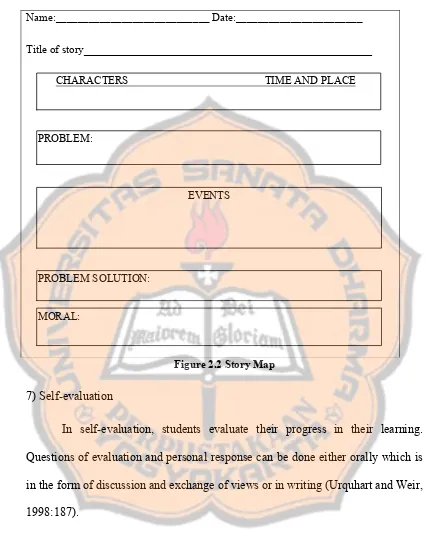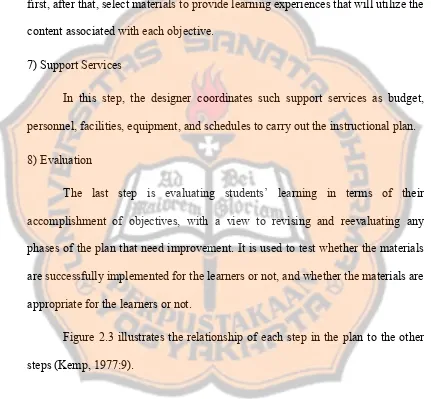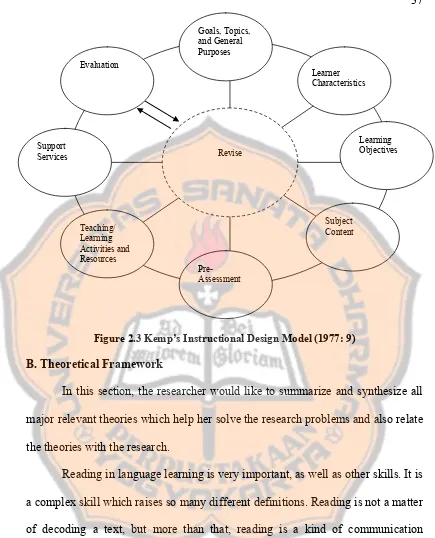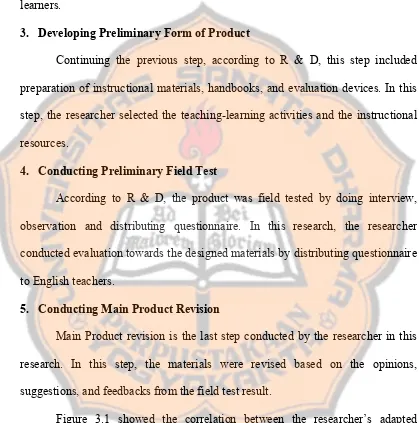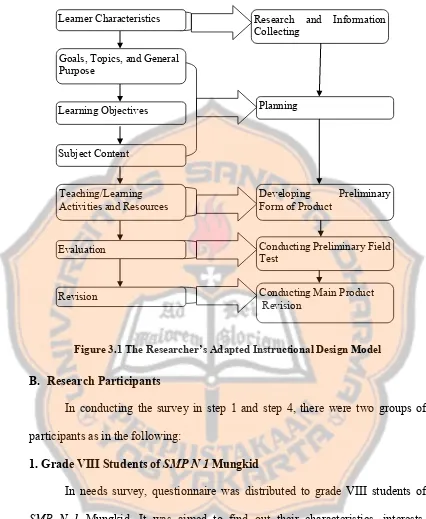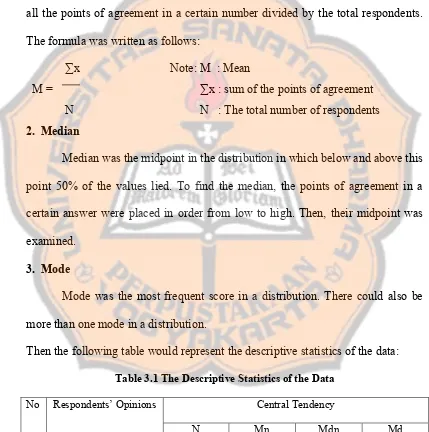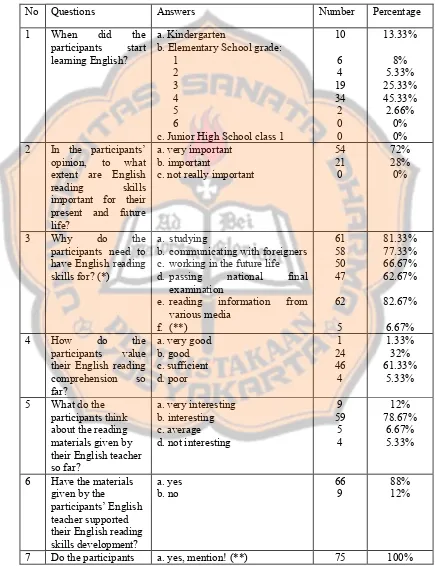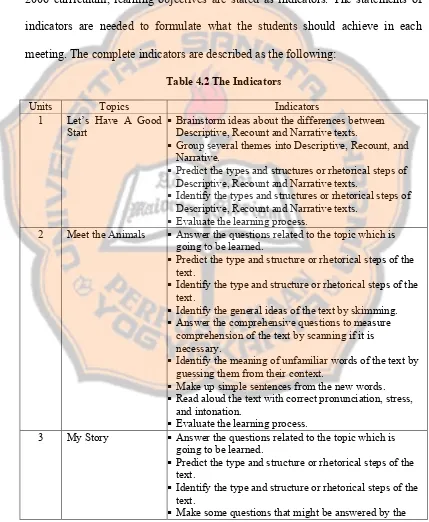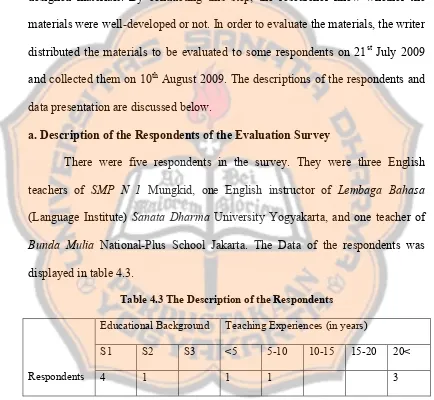A SET OF ENGLISH SUPPLEMENTARY READING MATERIALS
USING STRATEGIES-BASED INSTRUCTION
FOR GRADE VIII STUDENTS OF
SMP N 1 MUNGKID
A THESIS
Presented as Partial Fulfillment of the Require ments
to Obtain the Sarjana Pendidikan Degree
in English Language Education
By:
Kiki Purbosari
Student Number: 031214123
ENGLISH LANGUAGE EDUCATION STUDY PROGRAM
DEPARTMENT OF ARTS AND LANGUAGE EDUCATION
FACULTY OF TEACHERS TRAINING AND EDUCATION
SANATA DHARMA UNIVERSITY
YOGYAKARTA
i
A SET OF ENGLISH SUPPLEMENTARY READING MATERIALS
USING STRATEGIES-BASED INSTRUCTION
FOR GRADE VIII STUDENTS OF
SMP N 1 MUNGKID
A THESIS
Presented as Partial Fulfillment of the Require ments
to Obtain the Sarjana Pendidikan Degree
in English Language Education
By:
Kiki Purbosari
Student Number: 031214123
ENGLISH LANGUAGE EDUCATION STUDY PROGRAM
DEPARTMENT OF ARTS AND LANGUAGE EDUCATION
FACULTY OF TEACHERS TRAINING AND EDUCATION
SANATA DHARMA UNIVERSITY
YOGYAKARTA
iv
DEDICATION PAGE
Socrates was in jail, waiting for the death sentence on him to be done.
One day he heard his friend, other prisoner, was singing a difficult song
composed by Stesikoros.
Socrates asked that prisoner to teach him that song.
“Why?” asked the prisoner.
“So that I can die after I’ve known one new thing,” answered Socrates,
the noble person.
A Student: Why do you learn something new a week before you die?
A Teacher: With exactly the same reason as you learn something new
fifty years before you die.
(The Prayer of the Frog, by Antony de Mello)
This thesis is dedicated to:
My Lord, Allah SWT
My Prophet, Muhammad SAW
My beloved family
My teachers and lecturers
vii
ABSTRACT
Purbosari, Kiki. 2009. A Set of English Supplementary Reading Materials Using
Strategies-Based Instruction for Grade VIII Students of SMP N 1 Mungkid.
Yogyakarta: English Language Education Study Program, Sanata Dharma
University.
This research aims at designing a set of English supplementary reading
materials for grade VIII students of
SMP N
1
Mungkid. Reading is important in
English language learning because by reading English texts frequently, students
can learn and acquire English vocabulary and structures through reading
activities. To reach the goal of reading, readers can use strategies. In language
learning, those strategies are called language learning strategies that include
reading strategies. Since language learning strategies can support learners to
improve reading skills, in this research, the materials to be designed use
Strategies-Based Instruction. In Strategies-Based Instruction, language learning
strategies are integrated into everyday class materials, and may be explicitly or
implicitly embedded into teaching learning activities.
This research deals with two problems: (1) How is a set of English
supplementary reading materials using Strategies-Based Instruction for grade VIII
of
SMP N 1
Mungkid
designed? and (2)What does a set of English reading
materials using Strategies-Based Instruction for grade VIII of SMP N 1 Mungkid
look like? To answer the research questions above, five steps of R & D cycle were
applied. They were: (1) Conducting Research and Collecting Information, (2)
Planning, (3) Developing Preliminary Form of Product, (4) Conducting
Preliminary Field Test and (5) Conducting Main Product Revision. Besides, the
researcher adapted the principles of Strategies-Based Instruction in designing the
materials.
To solve the first problem, the researcher adapted the instructional design
model offered by Kemp. There were
seven steps to design the materials, namely:
(1)
Conducting needs survey, (2) Stating instructional goals, topics and general
purposes, (3) Specifying the objectives, (4) Listing the subject contents, (5)
Selecting the teaching learning activities and the instructional resources, (6)
Conducting an evaluation survey, and (7) Revising and improving the materials.
viii
the data. The results showed that most of the scores were more than 4. Therefore,
it could be concluded that most of respondents agreed that the designed materials
were acceptable and appropriate to be implemented. However, there were some
revisions that needed to be conducted to improve the designed materials.
To solve the second problem the researcher presented the final vers ion of
the designed materials after making some revisions and improvements based on
the results of the designed materials evaluation. The designed materials consisted
of ten units. Each unit contained three sections, they were: (1) Pre Work, (2) Get
Closer to Descriptive, Recount and Narrative Texts, and (3) Check Yourself for
Unit 1; (1) Build Your Knowledge, (2) Show Your Skills and (3) Check Yourself
for Unit 2 to 10.
ix
ABSTRAK
Purbosari, Kiki. 2009. A Set of English Supplementary Reading Materials Using
Strategies-Based Instruction for Grade VIII Students of SMP N 1 Mungkid.
Yogyakarta: Program Studi Pendidikan Bahasa Inggris, Universitas Sanata
Dharma.
Penelitian ini bertujuan untuk merancang seperangkat materi membaca
tambahan bahasa Inggris untuk siswa kelas VIII SMP N 1 Mungkid. Membaca
adalah hal yang penting dalam mempelajari bahasa Inggris karena dengan
membaca teks berbahasa Inggris secara teratur, siswa dapat mempelajari kosa kata
dan tata bahasa bahasa Inggris melalui kegiatan membaca. Untuk mencapai tujuan
membaca, pembaca dapat menggunakan strategi. Dalam pembelajaran bahasa,
strategi tersebut disebut strategi belajar bahasa (language learning strategies)
yang meliputi strategi membaca (reading strategies). Karena strategi belajar
bahasa dapat mendukung siswa dalam meningkatkan ketrampilan membaca,
dalam studi ini, materi yang dirancang menggunakan Instruksi Berbasis Strategi
(Strategies-Based Instruction). Dalam Instruksi Berbasis Strategi, strategi belajar
bahasa diintegrasikan ke dalam materi kelas sehari- hari, and bisa dimasukan
secara eksplisit atau implisit ke dalam kegiatan belajar mengajar.
Penelitian ini berhubungan dengan dua permasalahan: (1) Bagaimana
seperangkat materi membaca tambahan bahasa Inggris menggunakan Instruksi
Berbasis Strategi untuk siswa kelas VIII SMP N 1 Mungkid dirancang? dan (2)
Bagaimanakah bentuk materi membaca tambahan bahasa Inggris menggunakan
Instruksi Berbasis Strategi untuk siswa kelas VIII SMP N 1 Mungkid tersebut?
Untuk menjawab pertanyaan penelitian tersebut, lima langkah dari metode siklus
R & D (Research and Development) digunakan. Langkah- langkah tersebut adalah:
(1) Melaksanakan penelitian dan mengumpulkan informasi, (2) Perencanaan, (3)
Pengembangan bentuk awal dari produk, (4) Pengujian awal di lapangan, dan (5)
Perbaikan produk utama. Selain itu, peneliti juga mengadaptasi prinsip-prinsip
Instruksi Berbasis Strategi (Strategies-Based Instruction) dalam merancang
materi.
Untuk memecahkan masalah pertama, peneliti mengadaptasi sebual model
perancangan pembelajaran oleh Kemp. Ada tujuh langkah yang diterapkan dalam
perancangan materi, yaitu: (1) Mengadakan survey kebutuhan, (2) Menetapkan
sasaran, topik dan tujuan umum pembelajaran, (3) Menspesifikasikan tujuan, (4)
Mendaftar isi materi, (5) Memilih kegiatan belajar mengajar dan sumber-sumber
pembelajaran, (6) Mengadakan survey evaluasi, dan (7) Memperbaiki dan
meningkatkan materi.
x
Mungkid, seorang guru bahasa Inggris sekolah Bunda Mulia Jakarta, dan seorang
pengajar bahasa Inggris Lembaga Bahasa Universitas Sanata Dharma Yogyakarta,
untuk mendapatkan pendapat, komentar dan saran terhadap materi yang
dirancang. Peneliti menggunakan rumus
Central Tendency untuk menganalisa
data dari survey evaluasi tersebut. Hasilnya menunjukan bahwa sebagian besar
skor bernilai lebih dari 4. Oleh karena itu, dapat disimpulkan bahwa para
responden setuju bahwa materi yang dirancang dapat diterima dan sesuai untuk
diterapkan. Namun, beberapa perbaikan dilakukan untuk meningkatkan materi
yang dirancang.
Untuk memecahkan masalah yang kedua, peneliti menyajikan versi akhir
dari materi yang dirancang setelah membuat beberapa perbaikan dan peningkatan
berdasarkan hasil dari evaluasi materi yang dirancang. Materi yang dirancang
terdiri dari 10 unit. Masing- masing unit terdiri dari 3 bagian, yaitu: (1) Pre Work,
(2) Get Closer to Descriptive, Recount and Narrative Texts, and (3) Check
Yourself untuk unit 1; (1) Build Your Knowledge, (2) Show Your Skills, and (3)
Check Yourself untuk unit 2 sampai 10.
xi
ACKNOWLEDGEMENTS
In the name of Allah, the Most Gracious, and the Most Merciful: All
Praises to Allah, Lord of the Universe. Only because of His abundant blessings I
could accomplish my thesis. Salawat and regard will always be given to my
greatest guide, Muhammad SAW. His love, I believe, will always accompany me
and support me on any circumstances. I am also blessed to have people who have
supported me. It is a wonderful opportunity for me to express my deepest
gratitude to all of them.
My gratitude goes to Caecilia Tutyandari, S.Pd., M.Pd., my only sponsor
for her willingness and patience to guide me in writing this thesis. I thank her for
her support, suggestions, and advice, so that I could finish my thesis.
My thankfulness goes to my teachers and lecturers to whom I have
learned. The knowledge I gained until today could not be substituted with
anything. My thankfulness also goes to
PBI secretariat staffs and USD librarians
who helped and served me the best they can do. They really are the best people in
their fields.
I am indebted to the English teachers of
SMP N 1 Mungkid, Magelang
who helped me during the research, they are: Saryanti S.Pd., Kuntono M.H., S.Pd.
and Giarto S.Pd.. I am also deeply thankful to Maria Pujiastuti S.Pd. and Ag.
Kustulasari S.Pd., M.Ed.for giving feedbacks for my design.
xii
love, prayer, patience and encouragement. Words will never be enough to reveal
how much I thank them. My sweetest thank goes to my brothers; Widyo
Purnomo, Suryo Hanjono, Seno Yudhanto and sister in law Neni Wijayanti. I am
lucky just to have them who always care about me. I should be grateful to have
Bianca Fatima Az- zahra, my niece. She really makes my world cheerful. I would
also like to thank my grandparents for their support and prayer. I will not forget to
thank my uncles, aunts, and cousins who give me sincere love and consider me as
their own child and sister.
Next, I would like to dedicate my appreciation to my best friends, Titik,
Nina, Atik, Priska, and Melon for the friendship, support and unforgettable
experiences we have shared. I thank all PBI friends, especially Uri, Timur, Siwi,
Dheni, Dudunk, Gendut, Ceepok, Rinma, Upik, Beta, Indra and all my friends of
PBI 2003 for every moment we have during my study. I also thank Dita
“Cempoel” and Siska “Ncrut”. They have made my wo
rld more colourful. A
special thank goes to Diana to whom I can share my deepest even craziest
thought. She really has opened my mind.
Finally, my gratitude also goes to those whom I cannot mention by names.
May God bless them and make them prosperous.
xiii
TABLE OF CONTENTS
Page
TITLE PAGE ...
i
APPROVAL PAGES ... ii
DEDICATION PAGE ... iv
STATEMENT OF WORK’S ORIGINALITY
... v
LEMBAR PERNYATAAN PERSETUJUAN PUBLIKASI ... vi
ABSTRACT ... vii
ABSTRAK ... ix
ACKNOWLEDGEMENTS ... xi
TABLE OF CONTENTS ... xiii
LIST OF APPENDICES ... xvi
LIST OF FIGURES ... xvii
LIST OF TABLES ...
……….………xviii
CHAPTER I INTRODUCTION
A. Research Background ... 1
B. Problem Formulation ... 4
C. Problem Limitation ... 4
D. Research Objectives ... 4
E. Research Benefits ... 5
F. Definition of Terms ... 5
CHAPTER II THEORETICAL REVIEW
A. Theoretical Description ... 9
1. The Theory of Reading ... 10
a. Reading Definition ... 10
b. Reading Purposes ... 12
c. Reading Comprehension ... 13
xiv
e. Reading Skills and Strategies ... 16
2. The Teaching of Reading ... 16
a. Principles for Teaching Reading ... 17
b. The Stages in Teaching Reading ... 19
3. Strategies-Based Instruction ... 21
4. Integrating Strategies-Based Instruction (SBI) into the Reading
Materials ... 24
5. 2006 Curriculum ... 31
6. Grade VIII Students of Junior High School ... 32
7. Instructional Design Model ... 33
B. Theoretical Framework ... 37
CHAPTER III RESEARCH METHODOLOGY
A. Research Method ... 42
1. Conducting Research and Collecting Information ... 43
2. Planning ... 43
3. Developing Preliminary Form of Product ... 44
4. Conducting Preliminary Field Test ... 44
5. Conducting Main Product Revision ... 44
B. Research Participants ... 45
C. Research Setting ... 46
D. Research Instruments ... 46
1. Questionnaire ... 47
2. Interview ... 49
E. Data Gathering Technique ... 49
F. Data Analysis Technique ... 50
G. Research Procedure ... 52
CHAPTER IV RESEARCH RESULT ANDDISCUSSION
A. The Steps in Designing the Materials ... 54
xv
a. The Data of the Questionnaire ... 55
b. The Results of Interviewing the Teachers... 63
2. Stating Instructional Goals, topics and General Purposes ... 66
3. Specifying the Objectives ... 69
4. Listing the Subject Contents... 72
5. Selecting Teaching Learning Activities and Materials ... 74
6. Conducting an Evaluation Survey ... 76
7. Revising and improving the Materials ... 80
B. The Presentation of the Designed Materials... 82
CHAPTER V CONCLUSIONS AND SUGGESTIONS
A. Conclusions ... 84
B. Suggestions ... 86
xvi
LIST OF APPENDICES
Appendix
Page
APPENDIX A: Letter of Permission ... 92
APPENDIX B: Surat Keterangan Penelitian ... 94
APPENDIX C: List of Questions for Interview... 96
APPENDIX D: Questionnaire for Students ... 98
APPENDIX E: Questionnaire for Evaluating the Designed Materials ... 102
APPENDIX F: Gambaran Umum Materi ... 106
APPENDIX G: Syllabus ... 109
APPENDIX H: Lesson Plan... 116
xvii
LIST OF FIGURES
Figure
Page
Figure 2.1 Definition of Reading ... 11
Figure 2.2 Story Map ... 30
Figure 2.3 Kemp’s Instructional
Design Model... 37
xviii
LIST OF TABLES
Table
Page
Table 3.1 The Descriptive Statistic of the Data ... 51
Table 4.1 The Data of the Questionnaire for Students ... 56
Table 4.2 The Indicators... 69
Table 4.3 The Description of the Respondents ... 76
Table 4.4 The Descriptive Statistics of the Materials Evaluation Survey... 77
Table 4.5 The Presentation of the Materials ... 83
1
CHAPTER I
INTRODUCTION
This chapter presents the introduction, which is divided into six main
parts. The first part is the research background. The second part explains the
problem formulation of this study. The third part shows the problem limitation.
The fourth part deals with the research objectives and the fifth part with the
research benefits. The last part describes the definition of terms.
A.
Research Background
English is the first foreign language in Indonesia, which is taught to school
students as a compulsory subject. The purpose of teaching English is that the
students will have the ability in reading, listening, speaking, and writing using
English. As a result, the students will have communicative competence in English.
Having communicative competence in English enables them to explore
information source conveyed in English. Furthermore, they will be more prepared
to face globalization era, in which English is an important means of
communication around the world.
Reading, like listening, speaking, and writing, is a part of the
communicative competence of language users. By reading English text frequently,
learners can improve their language proficiency. Learners‟ reading proficiency
reading activities. English reading skills will also support learners in getting any
information which is written in English.
According to Anderson as edited by Nu
nan (2003: 68), “Reading is a
fluent process of readers combining information from a text and their own
background knowledge to build meaning.” Related to this fluent process, it may
include steps taken by learners or learners‟ strategies. In reading, thes
e strategies
should be adjusted according to the purpose of reading and the types of reading
texts. As a result, learners can build the meaning of their reading. It means that
they can reach the goal of reading that is comprehension or understanding of the
text.
Since language learning strategies especially reading strategies can support
learners to improve reading skills, in this research, the materials to be designed
use Strategies-Based Instruction or SBI which can be applied to all of the
language skills. Cohen (1998: 81) defines Strategies-
Based Instruction (SBI) as “a
learner centered approach to teaching that extends classroom strategy training to
include both explicit and implicit integration of strategies into the course content”.
Diane Larsen-Freeman uses the term learning strategy training which definition
can be said similar to Cohen‟s definition of SBI that is “training students in the
use of learning strategies in order to improve their learning effectiveness”
Language learning strategies can improve students‟ effectiveness in
learning the target language. To teach students to use various kinds of strategies to
develop their reading ability, the researcher decided to use Strategies-Based
Instruction in designing the supplementary reading materials for grade VIII
students of
SMP N 1
Mungkid. In Strategies-
Based Instruction, the teacher‟s job is
not only to teach language but also language-learning strategies which will
produce independent learners. Since the strategies are taught to students, they will
never be in doubt about what the strategies are, where, and when they can be used,
and how they are used.
Here the researcher tries to provide reading materials which offer the
opportunity to promote reading strategies. Besides, the materials are interesting
for the students and appropriate for their language level. Hopefully the materials
can help the students to minimize their weaknesses that impede them in
comprehending their reading such as the lack of background knowledge, problem
with words recognition, difficulties with language system, etc.
It becomes general opinion that English should be taught as early as
possible so that the students can have a better acquisition of English. It is just the
same as the researcher‟s belief that language
-learning strategies should be taught
as early as possible so that the students can have better language skills. It becomes
the thought of designing the materials for
SMP (Sekolah Menengah Pertama)
or
development which can support them to learn about language learning strategies
since they have already had the capacity to use hypotheses and abstract thinking.
B.
Problem Formulation
From the background, the researcher formulates the problems as follows:
1.
How is a set of English supplementary reading materials using
Strategies-Based Instruction for grade VIII students of
SMP N 1
Mungkid designed?
2.
What does a set of English supplementary reading materials using
Strategies-Based Instruction for grade VIII students of
SMP N 1
Mungkid look like?
C.
Problem Limitation
To limit the scope in order to be specific, this research focuses on
designing a set of English supplementary materials using Strategies-Based
Instruction (SBI) for grade VIII students of
SMP N
1
Mungkid. The researcher
also referred to 2006 curriculum for
SMP (Sekolah Menengah Pertama)
that will
influence the goal of the designed materials. The materials are aimed to add or
complete the existing materials. The materials emphasize on the enhancement of
students independence in learning English especially reading.
D.
Research Objectives
This research aims to:
2.
Present a set of English supplementary reading materials using
Strategies-Based Instruction for grade VIII of
SMP N
1
Mungkid.
E.
Research Benefits
The researcher hopes that the result of this research can be beneficial for
teachers, students and material designers. The benefits could be clarified as
follows:
1.
For teachers:
From this research, teachers who are interested to improve their students‟
reading skills and language proficiency may use various activities to teach
language learning strategies especially reading strategies in reading class.
2.
For students:
Strategy Instructions in the materials of this research can improve
students‟ comprehension and efficiency in reading. By using strategies, students
will read in the way that strategic readers do.
3.
For materials designers:
From this research, material designers will enrich their creativity and
knowledge in designing English instructional materials especially reading
materials.
F.
Definition of Terms
1. Reading
According to Anderson as edited by Nunan (2003:68) “Reading is a fluent
process of readers combining information from a text and their own background
knowledge to build meaning”. Walter (2004: 49) defines reading as
constructing
meaning trough an active process of students‟ thinking, reasoning, and applying
strategies. Reading in this study is defined as the process of receiving and
interpreting information from a text by applying reader‟s skills and strategies.
2. Comprehension
In this study, the term „comprehension‟ refers to reading comprehension.
Grabe & Stoller (2002: 17) said, reading comprehension means “…the ability to
understand information in a text and interpret it appropriately”. In this study,
comprehension is defined as how much a reader can get the information from a
text and understand it.
3. Strategies-Based Instruction
According to Cohen (1998: 81) “Strategies
-based instruction (SBI) is a
learner-centered approach to teaching that extends classroom strategy training to
include both explicit and implicit integration of strategies into the course content.”
It is also known as learner strategy training which is defined by Freeman as
(2000:160) “training students in the use of learning strategies in order
to improve
their learning effectiveness.” In this study, strategies
-based instruction is defined
4. Strategies
In this study the term „strategies‟ refers to langua
ge learning strategies or
learner‟s strategy especially reading strategies. Anderson as edited by Nunan
(2003: 77) writes “Strategies can be defined as conscious actions that learners take
to achieve desired goals or objective,…” Cohen (1998: 68) also uses
the element
of consciousness as he says “Language learning strategies are the conscious
thoughts and behaviors used by learners with the explicit goal of improving their
knowledge and understanding of a target language.” In this study “strategies” is
defined as learning processes which are consciously taken by learners during
language learning to achieve the desired goals in language learning.
5. Foreign Language, Second Language and Target Language
The researcher clarifies the terms Foreign Language (FL), Second
Language (SL), and Target language (TG) used in study. Cohen (1998: 4) writes:
Technically, learning a second language means that the language being
learned is that which is spoken in the community in which it is being learned,
while a foreign language is not spoken in the local community. The term
target language simply refers to that language being learned, whether as a
second or foreign language.
This study focuses on English as a foreign language teaching and learning. In this
study, the terms foreign language, second language and target language are used
interchangeably without contrasting the meaning. The same as Cohen (1998: 4),
the researcher uses the term Second Language as it serves “as the generic term
6. 2006 Curriculum
9
CHAPTER II
THEORETICAL REVIEW
This chapter presents the theories that underlie this research. The purpose
of this chapter is to get the understanding of what the basic principles of the
research are, so that the problems stated in the previous chapter can be answered.
There are two parts of this chapter i.e. theoretical description and theoretical
framework. In the theoretical description, the researcher presents some theories
related to this study, they are: the theory of reading, the teaching of reading,
Strategies-Based Instruction, integrating Strategies-Based Instruction into the
reading materials, 2006 curriculum, grade VIII students of Junior High School
and instructional design model. Meanwhile, in theoretical framework, the
researcher discusses the relation among the concepts stated before as the basis of
designing a set of English supplementary reading materials using Strategies-Based
Instruction for grade VIII of SMP N I Mungkid.
A.
Theoretical Description
This section presents related theories that support this research. There are
seven areas discussed, namely, the theory of reading, the teaching of reading,
Strategies-Based Instruction, integrating Strategies-Based Instruction into the
reading materials, 2006 curriculum, grade VIII students of Junior High School,
1.
The Theory of Reading
This part discusses reading definition, reading purposes, reading
comprehension, types of reading text, and reading skills and strategies.
a.
Reading Definition
To discuss reading, it is important to begin with the definition of the
concept. Wallace (1992: 2) says “… reading its
elf will mean different things in
different contexts,…”. Wallace gives some illustration how reading can mean
different things in different context. The three of the illustrations are as the
following: If a patient who is having a sight test reads a list of words, reading at
this situation means identifying the words; if a moslem reads aloud the Koran he
may probably just relate the written symbols to sound without knowing the
meaning; if a reader reads an instruction or procedure in order to be able to take
some action as a result, reading means interpreting. Thus, reading definitions have
a relationship with the reader‟s purpose, whether it is to identify the words,
decode the text, or relate the written symbols to sound or understand the text
(Wallace, 1992: 3).
Reading as interpreting the text can be an appropriate definition in the
context of language learning or any other subjects since the purpose is to
comprehend the text. Reading as interpreting according to Wallace (1992: 4) is
the writer and the reader in which the reader creates meaning of the text by
interpreting it.
Reading in a Foreign Language is different from reading in L1. To
interpret or understand a text in an FL, FL students need skills and strategies.
Their reading should be in a fluent process to become fluent readers. According to
Anderson edited by Nunan (2003: 68), “Reading is a fluent process of readers
combining information from a text and their own background knowledge to build
meaning.” He also presents a figure as a representation or the defini
tion of
reading:
Strategies Fluency
Reading
The Reader
The Text
Figure 2.1 Definition of Reading
(Anderson edited by Nunan, 2003:68)
The figure shows the overlapping circles among strategies, fluency, the reader, the
text, and reading. The intersection shown in the figure represents reading.
Walter (2004: 49) defines reading as constructing meaning trough an
active process of students‟ thinking, reasoning, and applying strategies. There are
similarities between the definition given by Anderson and the definition given by
Walter. Fluent process in And
erson‟s reading definition can be similar to active
process in Walter‟s reading definition. In both definitions, applying strategies is
b. Reading Purposes
At least a reader has one purpose in his/her reading. Usually the reading
purpose is influenced by its setting. Not only in academic setting, in everyday life
such as at home, in the street, in a market or in a public transportation, people do a
lot of readings. In academic setting, readers sometimes read complex texts with
the purpose of synthesizing the information. In everyday life, people read signs in
the street to get the right direction, and at home, people read newspapers or
magazines to be entertained or to use the information for a certain purpose.
To mention about reading purposes, it can be referred to the seven main
headings of reading purposes classified by Grabe and Stoller (2002: 12), they are:
reading to search for simple information, reading to skim quickly, reading to learn
from texts, reading to integrate information, reading to write (or search for
information needed for writing), reading to critique texts and reading for general
comprehension.
In the context of reading in FL or L2, reading purposes can also be
classified into three kinds of purposes as written by Wallace (1992: 65-69). Those
purposes are:
1. Reading for Specific Purposes
Learners of ESP (English for Specific Purposes) and EAP (English for
Academic Purposes) usually read texts from particular content areas such as
engineering or medicine. As a result, their purpose becomes specific too, that is to
2. Reading for General Purpose
Every EFL learner whether they are learners of ESP or not, they still need
and want to be general readers. As general readers, they probably read many kinds
of text types with various topics.
3. Reading for Pleasure in the Second Language
Different reader can have different choices of reading for pleasure in a
second language or a Foreign Language according to their interest.
c. Reading Comprehension
It is often agreed that the main goal of reading is comprehension.
Comprehension is also often connected to understanding about the information
from written texts. Since comprehension is considered as a major importance in
reading, many efforts are taken by readers when they do not understand the texts
such as re-reading it and looking up unfamiliar words in the dictionary.
Comprehension is more complex than just understanding a text or
interpreting a text appropriately. Grabe and Stoller (2002: 17) write that there are
10 processes involved in fluent reading comprehension as a set of necessary
processes of reading comprehension. They write, fluent reading is:
1)
A rapid process: It must occur rapidly in almost purposeful context so that the
other processes will actively arise.
2)
An efficient process: there should be an efficient combination among
3)
An interactive process: Various processes are conducted simultaneously and
the linguistic information from the text interacts with information activated by
the reader from long term memory, as background knowledge.
4)
A strategic process: In order to be fluent, a reader needs to be strategic.
5)
A flexible process: To be strategic, a reader should be able to read flexibly in
line with changing purposes and the ongoing monitoring of comprehension.
6)
An evaluating process: A reader must evaluate the text whether it is
appropriate with the purpose for reading.
7)
A purposeful process: Reading is purposeful not only based on differing
reading purposes but also individual purpose or task, whether imposed
internally or externally.
8)
A comprehending process: Understanding a text is the purpose of reading.
9)
A learning process: Through reading, students can learn new information.
10)
A linguistic process: It makes little sense to discuss or interpret a text without
engaging with it linguistically.
However, comprehension “can never be fully achieved” (Urquhart and
Weir, 1998: 88). Urquhart and Weir‟s reason why it
can never be fully achieved is
that readers can never be sure that they “have totally entered the writer‟s mind”.
Moreover, not all readings attempt to recover carefully author‟s meaning such as
skimming and scanning. There are also various level of comprehension which are
influenced by the reader‟s background knowledge, goals, interaction with the
d. Types of Reading text
Types of reading text are usually called genres. A definition of a genre
given by Wallace
(1992:145) is “…a text
-type which has a distinctive form and
content and which is socioculturally recognizable as serving a particular function,
for example „short story‟, „business‟ letter‟, „theater program‟.” Discussing kinds
of text are not only restricted to the discussion of literary forms such as novel,
short story or poem. It also can be extended to describe other types of text, such as
from the definition above it is said that business letter and theater program are
also the examples of genres. The other examples are menu, shopping list, recipe,
advertisements, etc.
Gerot and Wignel (1994) link the notions „genre‟ and „grammar‟. They
present 14 genres namely: spoof/recount, recounts, reports, analytical exposition,
news item, anecdote, narrative, procedure, description, hortatory exposition,
explanation, discussion, reviews and commentary. According to them, genres are
typified by social function, generic (schematic) structure, and significant
lexicogrammatical features. Texts of different genres build up meaning through
grammar in different ways. For example, Recounts which retell events tend to use
past tense and focus on specific participants (Gerot and Wignell, 1994: 194). On
the other hand, Reports which describe the way things are, tend to use simple
e. Reading Skills and Strategies
According to Grabe and Stoller (2002:17), “Strategies, for definitional
purpose, are best defined as abilities that are potentially open to conscious
reflection and use.” When reading strategies are a set of abilities under conscious
control of the reader, reading skills are automatic (Anderson as edited by Nunan,
2003; Grabe and Stoller, 2002 ). The connection between strategies and skills can
be like what Grabe and Stoller say that (2202:16) “… strategies are skills under
consideration.”
There are different strategies of reading for different situations (Wallace,
1992: 57). The strategies a reader chooses will depend on the purpose for reading.
For example, he might be reading for enjoyment, information, or to complete a
task. If he is exploring or reviewing, he might skim his reading. If he is searching
for information, he might scan for particular words. Depending on the purpose of
reading, the type of the text, and the context of situation, a reader sometimes
needs to adjust his/her reading strategies.
2. The Teaching of Reading
FL or L2 learners must be learners who have learned to read in one
language. This part will discuss principles for teaching reading and stages in
teaching reading which can be used by teachers to teach learners who are already
literate in at least one other language or first language and are learning how to
a. Principles for Teaching Reading
To be successful in teaching reading in an FL, an FL teacher should adapt
the principles for teaching reading. Anderson (as edited by Nunan, 2003) offers
good Principles for teaching reading. According to him there are eight principles
for teaching reading:
1) Exploit the reader‟s background knowledge
Because background knowledge can influence reading comprehension, it
is important to
activate students‟ background knowledge by
setting goals, asking
questions, making predictions, teaching text structure and so on.
2) Build a strong vocabulary base
Students‟ strong vocabulary base can support their success in reading. The
focus of teaching vocabulary explicitly in reading class is for teaching general,
basic vocabulary, while less frequent vocabulary are taught implicitly by teaching
the students to use context to effectively guess the meaning.
3) Teach for comprehension
Reading class should more emphasize on teaching students how to
comprehend the text rather than testing their comprehension. In doing so, the
teacher can encourage students to use cognitive skills that include what strategies
they can use to comprehend the text and metacognitive skills to monitor their
4) Work on increasing reading rate
To increase reading rate, the focus is not to develop speed-readers, but
fluent readers in which their reading rate and reading comprehension skills are in
balance.
5) Teach reading strategies
Teaching students to use a range of reading strategies should be a prime of
consideration in reading class to match their purposes for reading.
6) Encourage readers to transform strategies into skills
Reading teachers should encourage readers to transform strategies,
conscious actions that learners take to achieve desired goals or objectives, into
skills, strategies that have become automatic.
7) Build assessment and evaluation into your teaching
Both quantitative and qualitative aspects should be included in assessing
the students‟ reading skills. Quantitative assessment is gathered from students‟
scores of their reading comprehension, while qualitative assessment is gathered
from reading journal responses, reading interest surveys, and responses to reading
strategy checklist.
8) Strive for continuous improvement as a reading teacher
Reading teacher‟s quality facilitates the success of second/foreign
language readers. The success of reading teachers depends on how they facilitate
b. The Stages in Teaching Reading
There are three stages in teaching reading. The first stage is pre-reading
activities. The second stage is whilst reading activities and the third stage is post
reading activities.
1) Pre-reading Activities
The activities used in pre-reading serve as preparation to read a text.
Students are required to construct much meaning of the text before they reading it.
During pre-reading activities the teacher may:
-
prepare readers for linguistic features in the following text,
-
prepare readers for conceptual or cultural difficulties,
-
draw on readers‟ existing knowledge and views,
(Wallace, 1992: 86)
-
build a vocabulary base
-
establish a purpose(s) for reading
-
motivate the students to want to do the reading
(Durkin, 1987)
As a result, the students will be able to read the text more fluently or even
more independently. Pre-reading activities enable students to reduce their
dependent to the words on the text. They will also be able to minimize the
disadvantages of having less proficiency than native speakers have in the
2) Whilst-reading Activities
Whilst reading activities or while reading activities are the main part of
reading activities. These activities invite students to come into the content of the
text. In this part, students check their comprehension as they read. The students
use all the new vocabulary and background information while they are reading.
Therefore, the teacher must make sure that the preparation in the pre-reading
activities allows the students to read the entire material fluently.
Wal
lace (1992: 93) says “Many while
-reading tasks, with the aim of
encouraging active and reflective reading, attempt to promote the kind of dialogue
between reader and writer. Different genres offer opportunities for different
activities of this kind.” Diffe
rent genres mean different purpose for reading. Thus,
the examples of different activities stated above can be when students are reading
for specific information, students need to ask themselves: have they obtained the
information they were looking for? When reading for pleasure, students need to
ask themselves: do they understand the story well to enjoy the reading?
3) Post-reading Activities
Post-reading activities are evaluation of reading class activities. The
activities may be done either orally or written. Post-reading activities in the form
of questions of evaluation and personal response connect information in the text to
the outside world which consist of students own knowledge and experiences
problem-solving discussion, concluding and summarizing text, games, puzzle, role-play
etc.
3. Strategies-Based Instruction
Before discussing Strategies-Based Instruction, in this section, the writer
would like to discuss firstly the definition of the term language learning strategies
and the position of reading strategies in language learning strategies.
Cohen says (1998:68) “Language learning strategies are the conscious
thoughts and behaviors used by learners with the explicit goal of improving their
knowledge and understanding of a target language.” Since language learning
strategies must be conscious actions, consciousness in language learning strategies
differentiates these processes from other processes that are not strategic (Cohen,
1998:4).
Strategies in language learning include a range of substrategies from more
general to more specific. For example, “forming concepts and hypotheses about
how the target language works” is a general strategy, while “improving reading
comprehen
sion in the new language” is a specific strategy which has many
strategies that are more specific (Cohen, 1998:9). The examples of the more
specific strategies in improving reading comprehension can be skimming,
scanning, activating background knowledge, summarizing, etc.
Pertaining to the terms that refer to language learning strategy, the
literature includes other terms such as technique, tactic, move, macro-strategies
problem would be to refer to all of these simply as strategies, while still
acknowledging that there is a continuum from the broadest categories to the most
specific or low-
level.”
Language learning strategies can contribute success to language learning
whatever the skills are. The researcher finds that it is best to adapt one of the
options for providing strategy training that is Strategies-Based Instruction in
designing the reading materials in this study to develop learners as strategic
language learners. In Strategies-Based Instruction, students are explicitly taught
how, when, and why strategies can be used to facilitate language learning and
those strategies are integrated into the course content explicitly or implicitly
(Cohen1998: 81). It means that Strategies-Based Instruction facilitates students to
become more aware of the range of possible strategies that they can consciously
select during language learning and language use. Moreover, they can use those
strategies appropriately.
In a typical SBI classroom strategy-training situation, the teachers (Cohen
1998: 81):
1)
describe, model, and give examples of potentially useful strategies;
2)
elicit additional examples from students based on the students‟ own learning
experiences;
3)
lead small-group/whole class discussion about strategies (e.g. reflecting on the
rationale behind strategy use, planning an approach to a specific activity,
evaluating the effectiveness of chosen strategies);
5)
integrate strategies into everyday class materials, explicitly and implicitly
embedding them into the language tasks to provide for contextualized strategy
practice.
The components of explicit (as well as implicit) integration of learning
strategies into everyday class materials differentiate SBI from other options for
providing strategy training (Cohen, 1998:82). From what the teachers do in a
typical SBI classroom strategy-training it can be said that SBI expands the role of
teachers. Teachers‟ job is not
only to teach language content but also how to learn
the language or language learning strategies.
The goal of SBI is to help foreign language students become more aware
of (Cohen, 1998: 82):
1)
how they learn most effectively;
2)
how they can enhance their own comprehension and production of the target
language; and
3)
how they can continue to learn on their own and communication in the target
language after they leave the language classroom.
In brief, SBI encourages learners to be responsible for their own learning, not only
at the time they are joining SBI classroom but also in their further learning. It is
because they can transfer their ability to use language learning strategies in new
4. Integrating Strategies-Based Instruction (SBI) into the Reading Materials
In SBI, Cohen says (1998: 114) “strategies are integrated into everyday
class materials, and may be explicitly or implicitly embedded into the language
task”. By integrating strategies into teaching materials, students can learn how to
learn a foreign language while they are learning the language content. Cohen
writes (1998: 66-
67), “Students can improve both their learning skills and their
language skills when they are provided with the necessary tools to:
1)
self-diagnose their strengths and weaknesses in language learning;
2)
become more aware of what helps them to learn the language they are
studying most efficiently;
3)
develop a broad range of problem-solving skills;
4)
experiment with both familiar and unfamiliar learning strategies;
5)
make decision about how to approach a language task;
6)
monitor and self-evaluate their performance; and
7)
transfer successful strategies to new learning context.”
In integrating Strategies-Based Instruction into the reading materials
designed in this study, the researc
her refers to Cohen‟s first two options for how
to conduct SBI. Cohen writes “Teachers have at least three options for how to
conduct SBI”:
1)
They start with the established course materials and then determine which
strategies to insert and where.
2)
They start with a set of strategies that she wishes to focus on and design
3)
They insert strategies spontaneously into the lessons whenever it seems
appropriate.
As it has been said before, the researcher in this study adapts the first two
options above. First, after the reading passages have been collected, then the
strategies to insert and where are determined adjusting with the type of each
passage. Next, the activities around the strategies are designed.
Below are the strategies employed in the materials:
1) Predicting
Predicting is planning strategy. According to Urquhart & Weir (1998:185)
“After taking the decision to read a text, this strategy is used to anticipate the
content of a text; to make hypotheses about the macroproposition it might
contain.” To anticipate what is to come in the passage readers may predict the
vocabulary, content, and rhetorical structure of the text.
Levine (as edited by Day, 1993: 35) suggests that through prediction
strategies, a reading teacher can promote basic understanding of new vocabulary
through prediction strategies. It results a better understanding of the text and
motivation to read the text to confirm their guesses.
Edwin (as edited by Day, 1993: 44) writes that when readers practice
prediction of the structure of a text they will have a ready-made context for
interpreting hierarchies of ideas as well as vocabulary. This activity asks students
teacher to introduce possible rhetorical structures such as narrative, report,
procedure, problem/solution, etc.
2) Self Questioning
To enhance comprehension, in starting to read, readers can use
self-questioning strategy. Good self-self-questioning strategy promotes cognitive processes
such as inferencing, monitoring, understanding and concentrating to text structure
(Urquhart and Weir, 1998: 186). In this strategy, readers produce questions they
expect the text to answer. Spiegal (1981) as cited by Vacca and Vacca (1989:149)
su
ggest the development of an „Expectation Outline‟ to help students ask
questions about the text. The following are the directions of a variation on the
„Expectation Outline‟ called „Your Own Question‟ (Vacca and Vacca, 1989: 149):
a)
Have the students listen to or read a portion of text from the beginning of a
selection.
b)
Ask students to write five to ten questions that they think will be answered by
reading the remainder of the selection.
c)
Discuss some of the questions asked by the students before reading. Write the
questions on the board.
d)
Students then read to see if questions are answered.
e)
After reading, which questions were answered? Which weren‟t? Why not?
This strategy may have links with predicting and previewing strategies.
The questions in self-questioning may invite prediction or demand the students to
3) Skimming
Skimming is used to quickly identify the main ideas of a text. According
to Urquhart and Weir (1998:213) skimming is rapid in the rate of reading that
“involves processing
a text selectively to get the main idea(s) and the discourse
topic as efficiently as possible, which might involve both expeditious and careful
reading and both bottom-up and top-
down processing.” They add that purposes
for using this strategy might include:
a)
To establish a general a general sense of the text
b)
To quickly establish a macroproposional structure as an outline summary
c)
To decide the relevance of texts to establish needs
In skimming, a reader may reading the first and last sentence of each
paragraph carefully, identifying discourse markers, noting repeated key content
words, identifying markers of importance, skipping clusters of detail, glancing at
any non-verbal information, etc (Urquhart and Weir, 1998:214).
4) Scanning
When a reader knows what he is looking for, so he is concentrating on
finding a particular answer. The same as skimming, scanning is also rapid in the
rate of reading. According to Urquhart and Weir (1998: 215), scanning involves
moving the reader‟s eyes quickly down the page se
eking specific words/phrase,
figures/percentages, dates of particular events, or specific items in an
5) Dealing with Unknown Words
One of the best ways to acquire vocabulary in a Foreign Language may be
trough reading. By reading, students learn vocabulary from context. Learning
vocabulary from context can promote meaningful learning.
It is said (top-down models of reading) that to be fluent readers, students
should avoid word by word comprehension. However, in reading there are words
which may be unfamiliar to students but they are important for comprehension of
the text. Nutall (1996: 67-77) as cited by Urquhart and weir (19988: 199) provides
valuable activities as strategies for dealing with difficult words which are
important for comprehension:
a)
Looking for structural clues
b)
Grammatical function: its place in the sentence
c)
Morphology: its internal structure
d)
Inferencing its meaning from context
e)
Using a dictionary for unknown key words not accessible by other means.
Paran (1991,193) as cited by Urquhart and Weir (1998: 199) also offers
exercises as strategies that might be used to help students to acquire the meaning
of words such as:
a)
Relating a new word to a known word
b)
Contrasting a word with another word in the sentence
c)
Understanding the sentence as a whole
e)
Relating a word to a word in L1
Urquhart and Weir (1998:199) say, “It is noticeable that top
-down techniques are
being used here on occasion.”
6) Making a Story Map
Making text map is one of the ways t
o enhance students‟ comprehension
of the text. Grabe and Stoller use the term graphic organizers for map which
shows patterns of rhetorical organization through visual display. The visual
displays can be in various kinds of forms such as time lines, Venn diagrams,
compare/contrast matrices, flow charts, bar graphs, pay chart grids, family trees
etc (Grabe and Stoller, 2002: 216).
Related to choosing of this strategy, the researcher wanted to focus on
story map. It means that the type of text to be explored is narrative. According to
O‟Malley and Chamot (1994: 288) a story map identifies the story main features
and sequence of events which can help increase students‟ comprehension of a
story. As a language learning strategy, O‟Malley and Chamot (1994) catego
rize
making story map as one of taking notes strategy. Figure 4.2 on the next page
presents an example of story map format proposed by O‟Malley and Chamot
Figure 2.2 Story Map
7) Self-evaluation
In self-evaluation, students evaluate their progress in their learning.
Questions of evaluation and personal response can be done either orally which is
in the form of discussion and exchange of views or in writing (Urquhart and Weir,
1998:187).
According to Chamot, Kupper, and Impink-Hernandez, 1988 as cited by
O‟Malley and Chamot (1990: 137), Self
-evaluation may consist of:
a)
Production evaluation: checking
one‟s work when the task is finished.
b)
Performance evaluation: judging one‟s overall execution of the task.
Name:____________________________ Date:_______________________ Title of story________________________________________________CHARACTERS
TIME AND PLACEPROBLEM:
EVENTS
PROBLEM SOLUTION:

